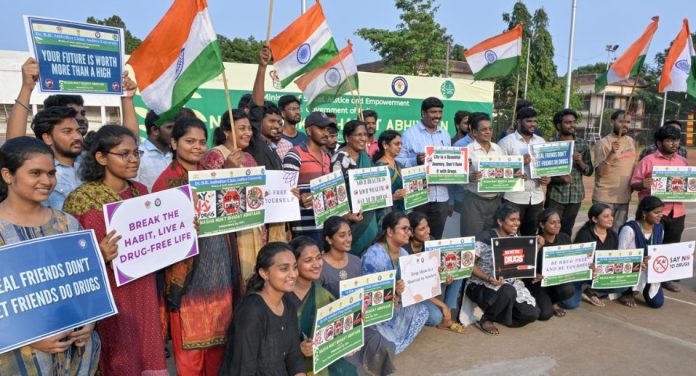The growing problem of drug addiction has become one of the most pressing concerns of modern society, affecting countless lives across various age groups. However, among the most vulnerable are young students who, due to peer pressure, curiosity, or academic stress, often find themselves drawn into the dangerous world of substance abuse. Recognizing the urgent need to address this crisis, a large-scale initiative titled ‘War Against Drugs’ has been launched to spread awareness and encourage young individuals to make a firm commitment to staying away from drugs. In a powerful display of unity and determination, thousands of students across the country took a pledge to remain drug-free, marking a significant milestone in the fight against drug abuse.
Substance abuse has far-reaching consequences that extend beyond the individual user, affecting families, communities, and the broader social fabric. Once addiction takes hold, it often leads to deteriorating health, broken relationships, financial struggles, and even criminal activity. Reports suggest that drug dependency among young people has been rising due to the easy availability of narcotics and the influence of social media, movies, and music that sometimes glorify drug use. Breaking free from addiction is not an easy task, making prevention the most effective solution. This is where the ‘War Against Drugs’ campaign comes in, aiming to equip students with the knowledge and resilience needed to make informed choices about their futures.
This nationwide movement brings together multiple stakeholders, including government bodies, law enforcement agencies, educational institutions, healthcare professionals, and social activists. Through a series of interactive workshops, seminars, and personal testimonials from recovered addicts, the initiative strives to instill a deep understanding of the devastating effects of drugs. Schools and colleges have played a crucial role in mobilizing students, ensuring that the message reaches every corner of society. Among the various activities organized under this campaign, one of the most impactful was the mass pledge taken by students, symbolizing their commitment to leading a drug-free life.
The pledge ceremony was a powerful moment, bringing together students from different backgrounds to stand in solidarity against drug abuse. With their hands raised, they solemnly vowed to resist the temptation of drugs, support their peers in making healthy choices, and actively spread awareness about the dangers of substance abuse. Many students shared personal experiences that had shaped their decision to take the pledge. Some had witnessed the devastating effects of addiction in their families, while others had friends who had fallen victim to drugs. Their commitment to staying drug-free was not just a personal decision but a promise to contribute to a healthier and safer community.

One of the students who participated in the pledge recounted how addiction had torn apart her family, leaving emotional and financial scars that had yet to heal. She expressed her determination never to go down the same path, emphasizing how important it was for young people to educate themselves about the risks of drug use. Another student, who had experimented with drugs but managed to turn his life around, shared how a moment of poor judgment had nearly cost him his future. His story served as a stark reminder of how quickly substance abuse can spiral out of control, reinforcing the need for vigilance and support from family and friends.
Beyond the students themselves, educators and school administrators played a vital role in ensuring the success of the campaign. Many institutions have adopted a zero-tolerance policy towards drugs, implementing strict measures to prevent the sale and use of illegal substances on their premises. Schools have also begun incorporating anti-drug education into their curricula, ensuring that students receive accurate information about the physical, mental, and social consequences of addiction. Counseling services have been expanded to provide emotional and psychological support to students struggling with stress, anxiety, or peer pressure—factors that often contribute to substance abuse.
Parents, too, have a critical role in this movement. Open communication between parents and children is essential in preventing drug abuse, as young people are more likely to seek guidance from their families if they feel supported and understood. The campaign encourages parents to educate themselves about the signs of drug use and to create an environment where their children feel comfortable discussing their concerns. When families take an active interest in their children’s lives and provide them with positive role models, the likelihood of drug experimentation significantly decreases.
The community at large must also take responsibility for fostering a drug-free culture. Local organizations, religious groups, and youth clubs have stepped forward to support the campaign by organizing awareness programs and outreach activities. Neighborhoods with strong social bonds tend to have lower rates of drug abuse, as individuals feel a greater sense of accountability and belonging. Volunteers have been working tirelessly to distribute informational pamphlets, host discussions, and engage with young people to offer guidance and encouragement.
The government has strengthened its efforts to tackle the drug crisis by tightening laws against drug trafficking and increasing funding for rehabilitation centers. Law enforcement agencies have been working to dismantle drug networks, preventing illegal substances from reaching young people. Additionally, public awareness campaigns have been launched through television, radio, and social media platforms to ensure that the anti-drug message reaches the widest audience possible. These efforts have been instrumental in changing perceptions about drug use and reinforcing the importance of a collective fight against addiction.
Despite the progress made, sustaining this momentum remains a challenge. The fight against drugs is not a one-time event but an ongoing commitment that requires continuous education, vigilance, and support systems. Schools must continue to host awareness programs, peer support groups should be strengthened, and community engagement should be encouraged. Regular evaluations of anti-drug initiatives will help identify gaps and areas that need improvement, ensuring that efforts remain effective and relevant. Furthermore, integrating extracurricular activities such as sports, music, and art into students’ daily lives can provide them with constructive outlets for stress and self-expression, reducing the likelihood of drug experimentation.
The mass pledge taken by students under the ‘War Against Drugs’ drive marks a significant step in the right direction. It represents a generation that is willing to take responsibility for its future and reject the destructive path of substance abuse. By standing together, students, parents, educators, law enforcement, and the government can create a society where drug addiction is no longer a looming threat. The key to success lies in sustained efforts, open conversations, and unwavering determination to build a healthier, drug-free world.
As the campaign moves forward, the collective responsibility of ensuring a drug-free future must remain at the forefront of social and governmental priorities. The stories of resilience and transformation shared by students and recovered addicts serve as powerful reminders that change is possible. With continued education, community support, and firm policies, the battle against drugs can be won. The pledge taken by students is more than just words—it is a promise to themselves, their families, and society that they will strive for a brighter, healthier, and addiction-free future.


